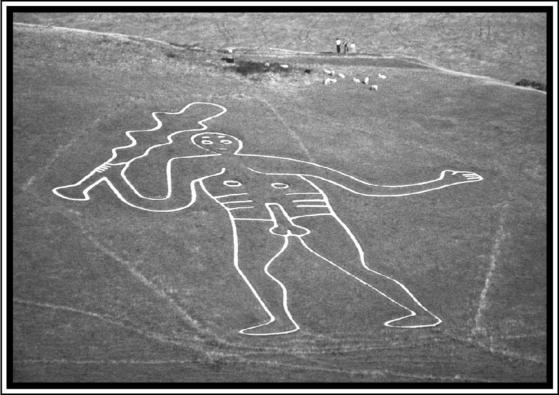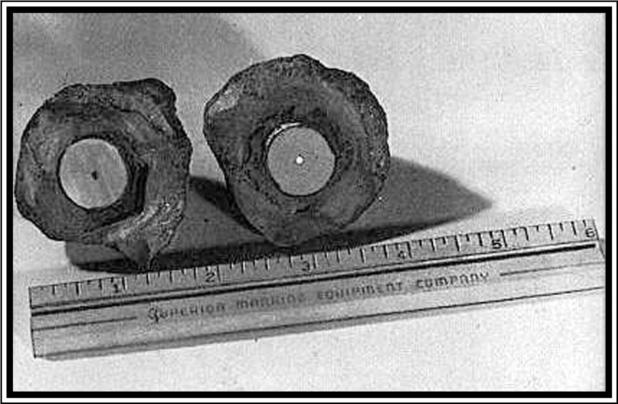Hidden History: Lost Civilizations, Secret Knowledge, and Ancient Mysteries (29 page)
Read Hidden History: Lost Civilizations, Secret Knowledge, and Ancient Mysteries Online
Authors: Brian Haughton
Tags: #Fringe Science, #Gnostic Dementia, #U.S.A., #Alternative History, #Amazon.com, #Retail, #Archaeology, #History

Alternatively, the carving may
have been created for ritual/religious
purposes. Some see the horse as representing the Celtic horse goddess
Epona, who was worshipped as a protector of horses, and also had associations with fertility. However, the cult
of Epona was imported from Gaul (France) probably in the first century
A.D., which is when we find the first
depictions of the horse goddess. This
date is at least six centuries after the
Uffington Horse was carved. Nevertheless, the horse was of great ritual and
economic importance during the
Bronze and Iron Ages, as attested by
its depictions on jewelry, coins, and
other metal objects. Perhaps the carving represents a native British horsegoddess, such as Rhiannon, described
in later Welsh mythology as a beautiful woman dressed in gold and riding
a white horse. Others see the White
Horse as connected with the worship
of Belinos or Belinus, "the shining
one," a Celtic Sun God often associated
with horses. Bronze and Iron Age sun
chariots (mythological representations
of the sun in a chariot), were shown as
being pulled by horses, as can be seen
from the 14th century B.c. example from
Trundholm in Denmark. If, as is now
believed, Celtic culture had reached
Britain by the very end of the Bronze
Age, then the White Horse could still
be interpreted as a Celtic horsegoddess symbol.
There are some who believe that
the great carving does not represent
a horse at all, but rather a dragon. A
legend connected with Dragon Hill, a
low natural flat-topped mound situated in the valley below the White
Horse, suggests that the horse depicts
the mythical dragon slain by St.
George on that hill. The blood of the
dying dragon was supposed to have
been spilled on Dragon Hill, leaving a
bare, white chalk scar where, to this
day, no grass will grow. Perhaps the
St. George connection with the White
Horse is a confused memory of some
strange prehistoric ritual performed
on Dragon Hill by its creators, perhaps
as long as 3,000 years ago. Up until the
late 19th century the White horse was
scoured every year, as part of a two
day Midsummer country fair, which
also included traditional games and
merrymaking. Nowadays, the accompanying festival is gone, and the task
of maintaining the horse is undertaken
by English Heritage, the organization
responsible for the site. The last scouring took place on June 24, 2000.
A further example of an ancient
horse is the Red Horse of Tysoe, which
once existed on the Edgehill scarp,
above the village of Lower Tysoe in
Warwickshire. Unfortunately, this
strange creature, actually multiple
horses carved in the same area, was
ploughed over and disappeared in
1800. The history and design of the Red
Horse is obscure. It was first mentioned in 1607 in Britanica, written by
the English antiquarian and historian
William Camden. In the 17th century,
the English traveler Celia Feinnes
described the horse when travelling
through the area, writing, "It's called
the Vale of Eshum or `of the Red Horse'
from a red horse cut on some of the
hills about it, and the Earth all looking red the horse lookes so as that of
the White Horse Vale." Since the
1960s, investigation into the Red Horse
using ground survey, aerial photographs, and local archives research
has managed to locate as many as six
separate horses. At present, the consensus of opinion is that the original
Red Horse of Tysoe, or Great Horse,
was cut in Anglo-Saxon times around
A.D. 600, possibly as a representation
of the Saxon war god Tiw or Tiu, from
whom the village of Tysoe allegedly takes its name, and from where we get
our word Tuesday (Tiw's day).

Photograph courtesy of SacredSites.com.
The Cerne Abbas giant.
Almost as well-known as the
Uffington White Horse is the 180 foot
tall Cerne Abbas Giant, an ithyphallic
figure cut into the hillside to the northeast of the village of Cerne Abbas, and
to the north of Dorchester, Dorset.
The carving is of a giant, roundheaded, naked man with a distinct
erect penis and testicles, wielding a
huge knobbed club in his right hand.
As with the White Horse at Uffington,
it is not possible to fully appreciate the
figure from the ground; only from the
air can the giant be seen in all his
glory. Above the giants's head lies a
rectangular earthwork enclosure,
called the Trendle, or frying pan,
thought possibly to be an Iron Age
temple site, which some researchers
believe is connected with the huge
chalk figure below it. The favorite interpretations of the Cerne Giant is
that he either represents a prehistoric
fertility god or a Roman carving of
Hercules wielding his giant club. Up
until 1635 there were Mayday fertility celebrations on the hill, with the
maypole being erected inside the
Trendle, around which locals would
dance.
However, unlike the Uffington
White Horse, the earliest surviving
reference to the Cerne Giant dates
only as far back as 1694, when it is
mentioned in the village church's accounts. It was subsequently surveyed
in 1764, and the results published in
the Gentleman's Magazine that year.
Writing in 1774, John Hutchins in his
History and Antiquities of the County
of Dorset, states that the figure was
supposed to have been cut in the
middle of the 17th century as a joke,
though he also mentions that some of
the older residents of the village had
in the past claimed it had been there
"beyond the antiquity of man." However, the weight of evidence does tend
to support a recent origin for the giant. One theory is that although the
giant is indeed a depiction of Hercules,
it actually represents a caracature of Oliver Cromwell, who was sometimes
referred to as the English Hercules,
and was cut on the instructions of local landowner Denzil Holles some time
in the 1640s. Another factor that supports this date is that medieval records
always refer to the hill on which the
giant is carved as Trendle Hill, rather
than the modern Giant Hill, making no
mention of the huge carving. This
would indicate that the giant has only
existed for about 400 years. Another
interpretation, however, would be that
for some reason, perhaps its overt
sexuality, writers chose to ignore the
Cerne Giant. Perhaps it had even become overgrown and forgotten.
New research into another chalk
giant, however, may add support to the
more recent date for the Cerne Abbas
figure. Carved into the steep slopes of
Windover Hill, Sussex, the 226-feethigh Long Man of Wilmington is the
tallest hill figure in England, and was,
until recently, believed to be of prehistoric origin. But the latest archaeological study at the site (using the
same OSL dating technique as on the
Uffington White Horse) produced evidence that the earlier theories are
wrong and that the figure had been
carved as recently as A.D. 1545. Although the new dating of the
Wilmington Giant to the medieval period does throw considerable doubt on
the prehistoric credentials of the
Cerne Abbas Giant, until OSL dating
is carried out on the carving, the giant
English Hercules will remain an
enigma.
The reasons for the creation of
these hill figures are probably as varied as the figures represented. New
archaeological and geological evidence
is increasingly indicating a medieval
date for the giant naked figures, which
some historians have argued were
products of an age of civil war and extreme political turmoil in England,
when satire was sometimes the only
weapon. Compared to the huge stone
permanence of structures, such as the
Avebury Monuments and Stonehenge,
hill figures are much more transitory;
10 or 20 years without scouring, and
the carving could be lost forever. The
fact that the figures could disappear
so easily, along with their associated
rituals and meaning, indicates that
they were never intended to be anything more than temporary gestures,
which have only survived either by
accident, or, in the case of the
Uffington White Horse Abbey, by the
continued existence of extraordinarily tenacious local tradition. But this
does not lesson their importance.
These giant carvings are a fascinating
glimpse into the lives and minds of
their creators and how they viewed
the landscape in which they lived.


The original artifact inside the supposed geode.
For some people, out of place artifacts (objects found in contexts that are
out of sync with the accepted chronology of human history) seriously question what we think we know about the
world and its history. Some argue that
these discoveries offer persuasive evidence that in remote antiquity, mankind was significantly more advanced
than we could ever imagine. They insist that at various times in prehistory
we have reached a high level of civilization, only for it to be subsequently
destroyed, without a trace, by natural
or man-made catastrophes. The evidence for such hypothetical ancient
civilizations consists mainly of what
appear to be fossilized human footprints, such as those discovered in the
1880s at the summit of Big Hill in the
Cumberland Mountains in Jackson
County, Kentucky (The American Antiquarian, January 1885), and apparently man-made objects enclosed in
pieces of coal or rock. The Coso Artifact is such an example.
On February 13, 1961, Wallace
Lane, Virginia Maxey, and Mike
Mikesell (co-owners of the LM&V
Rockhounds Gem and Gift Shop in
Olancha, southern California) were out in the Coso Mountains looking for
interesting mineral specimens, particularly geodes (hollow, usually spheroid rocks with crystals lining the inside
wall, cmmonly around 500,000 years
old) for their collection. At lunchtime,
after they had been collecting rocks,
close to the top of a 4,265 foot peak,
overlooking the dry bed of Owens Lake,
they put their specimens in the rock
sack and headed home.
The next day, while attempting to
cut through one of the finds that appeared to be a geode, Mikesell severely
damaged a practically new diamond
saw. Finally, when the nodule was
opened, he found a thick circular section of white porcelain material, in the
center of which was a 2 millimeter rod
of bright metal. This metal proved to
be magnetic. The porcelain cylinder
was itself enclosed by a hexagonal
sheath of decomposing copper and another unidentifiable substance. The
discoverers noticed other strange
qualities about the stone. Its outer
layer was encrusted with bits of fossil
shell, hardened clay, and pebbles, and
more surprisingly, two nonmagnetic
metal objects which looked similar to
a nail and a washer. Puzzled by the
find, the group began showing it to
friends and associates, though little
record remains now of original examinations of the object. One of the discoverers, Virginia Maxey, said that a
geologist who examined the object
gave its age, based on the fossils encrusted in its shell, as at least 500,000
years old. However, this unnamed geologist has never been traced and the
conclusion was never published. But if
these conclusions could be supported,
then the implications are clear. If the
Coso Artifact is a genuine example of